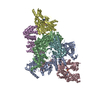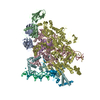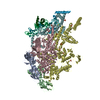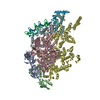登録情報 データベース : PDB / ID : 7kw7タイトル Atomic cryoEM structure of Hsp90-Hsp70-Hop-GR Glucocorticoid receptor Heat shock 70 kDa protein 1A Heat shock protein HSP 90-alpha Stress-induced-phosphoprotein 1 キーワード / 機能・相同性 分子機能 ドメイン・相同性 構成要素
/ / / / / / / / / / / / / / / / / / / / / / / / / / / / / / / / / / / / / / / / / / / / / / / / / / / / / / / / / / / / / / / / / / / / / / / / / / / / / / / / / / / / / / / / / / / / / / / / / / / / / / / / / / / / / / / / / / / / / / / / / / / / / / / / / / / / / / / / / / / / / / / / / / / / / / / / / / / / / / / / / / / / / / / / / / / / / / / / / 生物種 Homo sapiens (ヒト)手法 / / / 解像度 : 3.57 Å データ登録者 Wang, R.Y. / Noddings, C.M. / Kirschke, E. / Myasnikov, A. / Johnson, J.L. / Agard, D.A. 資金援助 組織 認可番号 国 Howard Hughes Medical Institute (HHMI)
ジャーナル : Nature / 年 : 2022タイトル : Structure of Hsp90-Hsp70-Hop-GR reveals the Hsp90 client-loading mechanism.著者 : Ray Yu-Ruei Wang / Chari M Noddings / Elaine Kirschke / Alexander G Myasnikov / Jill L Johnson / David A Agard / 要旨 : Maintaining a healthy proteome is fundamental for the survival of all organisms. Integral to this are Hsp90 and Hsp70, molecular chaperones that together facilitate the folding, remodelling and ... Maintaining a healthy proteome is fundamental for the survival of all organisms. Integral to this are Hsp90 and Hsp70, molecular chaperones that together facilitate the folding, remodelling and maturation of the many 'client proteins' of Hsp90. The glucocorticoid receptor (GR) is a model client protein that is strictly dependent on Hsp90 and Hsp70 for activity. Chaperoning GR involves a cycle of inactivation by Hsp70; formation of an inactive GR-Hsp90-Hsp70-Hop 'loading' complex; conversion to an active GR-Hsp90-p23 'maturation' complex; and subsequent GR release. However, to our knowledge, a molecular understanding of this intricate chaperone cycle is lacking for any client protein. Here we report the cryo-electron microscopy structure of the GR-loading complex, in which Hsp70 loads GR onto Hsp90, uncovering the molecular basis of direct coordination by Hsp90 and Hsp70. The structure reveals two Hsp70 proteins, one of which delivers GR and the other scaffolds the Hop cochaperone. Hop interacts with all components of the complex, including GR, and poises Hsp90 for subsequent ATP hydrolysis. GR is partially unfolded and recognized through an extended binding pocket composed of Hsp90, Hsp70 and Hop, revealing the mechanism of GR loading and inactivation. Together with the GR-maturation complex structure, we present a complete molecular mechanism of chaperone-dependent client remodelling, and establish general principles of client recognition, inhibition, transfer and activation. 履歴 登録 2020年11月30日 登録サイト / 処理サイト 改定 1.0 2021年12月8日 Provider / タイプ 改定 1.1 2022年1月26日 Group / カテゴリ / citation_authorItem _citation.country / _citation.journal_abbrev ... _citation.country / _citation.journal_abbrev / _citation.journal_id_ASTM / _citation.journal_id_CSD / _citation.journal_id_ISSN / _citation.pdbx_database_id_DOI / _citation.pdbx_database_id_PubMed / _citation.title / _citation.year / _citation_author.identifier_ORCID / _citation_author.name 改定 1.2 2022年2月2日 Group / カテゴリ / citation_authorItem _citation.journal_volume / _citation.page_first ... _citation.journal_volume / _citation.page_first / _citation.page_last / _citation.year / _citation_author.identifier_ORCID 改定 1.3 2024年5月29日 Group / カテゴリ / chem_comp_bond
すべて表示 表示を減らす
 データを開く
データを開く 基本情報
基本情報 要素
要素 キーワード
キーワード 機能・相同性情報
機能・相同性情報 Homo sapiens (ヒト)
Homo sapiens (ヒト) データ登録者
データ登録者 米国, 1件
米国, 1件  引用
引用 ジャーナル: Nature / 年: 2022
ジャーナル: Nature / 年: 2022

 構造の表示
構造の表示 ムービービューア
ムービービューア Molmil
Molmil Jmol/JSmol
Jmol/JSmol ダウンロードとリンク
ダウンロードとリンク ダウンロード
ダウンロード 7kw7.cif.gz
7kw7.cif.gz PDBx/mmCIF形式
PDBx/mmCIF形式 pdb7kw7.ent.gz
pdb7kw7.ent.gz PDB形式
PDB形式 7kw7.json.gz
7kw7.json.gz PDBx/mmJSON形式
PDBx/mmJSON形式 その他のダウンロード
その他のダウンロード 7kw7_validation.pdf.gz
7kw7_validation.pdf.gz wwPDB検証レポート
wwPDB検証レポート 7kw7_full_validation.pdf.gz
7kw7_full_validation.pdf.gz 7kw7_validation.xml.gz
7kw7_validation.xml.gz 7kw7_validation.cif.gz
7kw7_validation.cif.gz https://data.pdbj.org/pub/pdb/validation_reports/kw/7kw7
https://data.pdbj.org/pub/pdb/validation_reports/kw/7kw7 ftp://data.pdbj.org/pub/pdb/validation_reports/kw/7kw7
ftp://data.pdbj.org/pub/pdb/validation_reports/kw/7kw7 リンク
リンク 集合体
集合体
 要素
要素 Homo sapiens (ヒト) / 遺伝子: HSP90AA1, HSP90A, HSPC1, HSPCA / 発現宿主:
Homo sapiens (ヒト) / 遺伝子: HSP90AA1, HSP90A, HSPC1, HSPCA / 発現宿主: 
 Homo sapiens (ヒト) / 遺伝子: HSPA1A, HSP72, HSPA1, HSX70 / 発現宿主:
Homo sapiens (ヒト) / 遺伝子: HSPA1A, HSP72, HSPA1, HSX70 / 発現宿主:  unidentified baculovirus (ウイルス) / 参照: UniProt: P0DMV8
unidentified baculovirus (ウイルス) / 参照: UniProt: P0DMV8 Homo sapiens (ヒト) / 遺伝子: STIP1 / 発現宿主:
Homo sapiens (ヒト) / 遺伝子: STIP1 / 発現宿主: 
 Homo sapiens (ヒト) / 遺伝子: NR3C1, GRL / 発現宿主:
Homo sapiens (ヒト) / 遺伝子: NR3C1, GRL / 発現宿主: 





 試料調製
試料調製 電子顕微鏡撮影
電子顕微鏡撮影
 FIELD EMISSION GUN / 加速電圧: 300 kV / 照射モード: FLOOD BEAM
FIELD EMISSION GUN / 加速電圧: 300 kV / 照射モード: FLOOD BEAM 解析
解析 ムービー
ムービー コントローラー
コントローラー

















 PDBj
PDBj






































